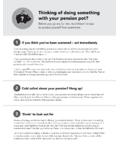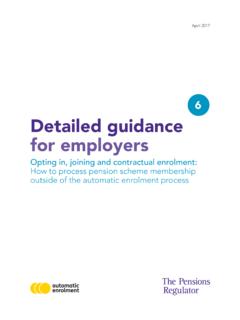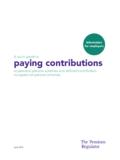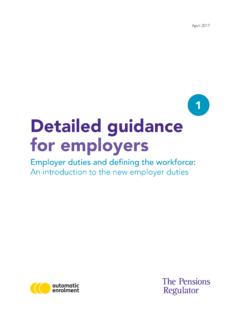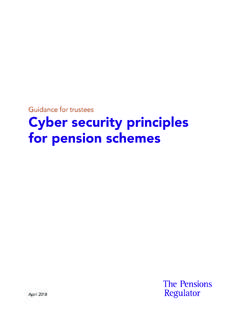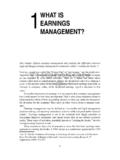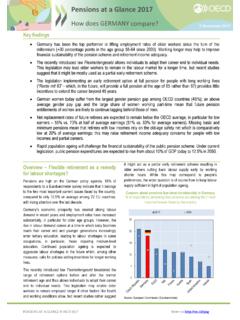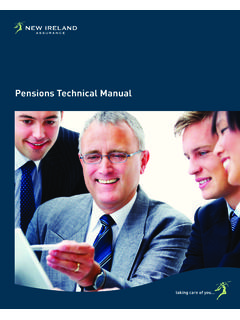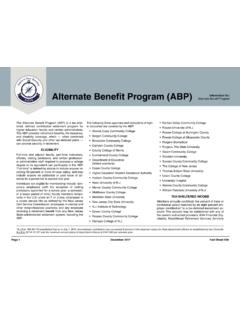Transcription of 9 Detailed guidance for employers - The Pensions Regulator
1 April 2017 Keeping records: Records that must be kept by law under the new employer dutiesDetailed guidance for employers9 Detailed guidance for employers no. 9 Keeping records2 Automatic re-enrolment1233a3b3c4567891011 Publications in the seriesEmployer duties and defining the workforce An introduction to the new employer dutiesGetting ready First steps to prepare for the new employer dutiesAssessing the workforce How to identify the different categories of workerPostponementTransitional period for schemes with defined benefitsHaving completed the assessmentPension schemes pension schemes under the new employer dutiesAutomatic enrolment An explanation of the automatic enrolment processOpting in.
2 Joining and contractual enrolment How to process pension scheme membership outside of the automatic enrolment processOpting out How to process opt-outs from workers who want to leave a pension schemeSafeguarding individuals The new safeguards for workersKeeping records Records that must be kept by law under the new employer dutiesInformation to workersDetailed guidance for employers no. 9 Keeping records3 Publications in the seriesAccompanying resourcesInformation to workers Summary of information requirements in a quick-reference table formatThe different types of worker Diagram of the different categories of worker and the criteria for each categoryEmployer duties and safeguards At-a-glance summary of the duties and safeguardsDetailed guidance for employers no.
3 9 Keeping records4 Contents About this guidance 5 Introduction 6 Overview of record-keeping requirements 7 Types of records that must be kept 7 Collecting and storing scheme records 7 Easy-reference tables 9 Key terms: Summary of the different categories of worker 12pageDetailed guidance for employers no.
4 9 Keeping records5 About this guidanceThis guidance is aimed at professional advisers and employers with in-house Pensions professionals. It provides a summary of the record-keeping requirements under the new employer duties, as referred to in the rest of the guidance in this series. It sets out essential information on what type of records the legislation requires an employer to the content in this guidance is applicable to both eligible jobholders and non-eligible jobholders, we have used the term jobholder in its wider recognise that many employers will already have pension provision for their workers, and that this will often match or exceed the minimum requirements contained in the duties.
5 In these cases, such employers may just need to check that the minimum requirements are covered in their existing employers must provide the Regulator with certain information about how they have complied with their duties. They must submit this information within five months of their staging date. The information can be submitted at It will be helpful to employers to be familiar with the different categories of workers. These are explained in detail in Detailed guidance no. 1 Employer duties and defining the workforce or a quick reminder is available in Key guidance forms part of the Detailed guidance for employers (published April 2017).
6 There have been no updates since the last guidance for employers no. 9 Keeping records6 Introduction1. With the introduction of the employer duties in 2012, there is a legal requirement on employers , trustees, managers and providers to keep certain The records an employer must keep will enable them to prove that they have complied with their duties. Keeping accurate records also makes good business sense because it can help an employer to: avoid or resolve potential disputes with employees help check or reconcile contributions made to the pension This guidance sets out the records that must, by law, be kept by employers and providers under the new legislation.
7 4. Good governance, including record-keeping, has always been considered vital to the effective and efficient running of a pension scheme. The Regulator has previously produced guidance on the importance of good record-keeping. Although aimed at trustees and professional advisers, employers may find it useful. For further information, visit: guidance for employers no. 9 Keeping records7 Overview of record-keeping requirements5. After an employer s staging date, they must: keep certain records on aspects of their compliance with the new duties preserve those records produce those records to the Regulator , if of records that must be kept6.
8 By law, there are two different types of records that an employer must keep. These are: Records about jobholders and workers: eg name, National Insurance number, opt-in notice and joining notice Records about the pension scheme: eg employer pension scheme reference and scheme name and Most of these records must be kept for a minimum of six years, with the exception of those relating to opt-outs, which must be kept for four years. For more information, see Easy-reference and storing scheme records8. employers can use their existing business documentation (eg payroll records) for the purpose of collecting and storing records, but should note that the notices (an opt-in notice, joining notice or opt-out notice) must be retained in the original format, as this is proof of an individual exercising a right.
9 Copies of the original format, or electronically-stored versions, are acceptable. However, all records must be kept in such a form and manner that they are legible or can be provided to the Regulator in a legible employers who outsource business or Pensions administration to a third party can continue to do so. They may authorise the third party to keep, preserve or provide the records on their behalf. However, it remains an employer s legal responsibility to ensure these records are kept and, if requested, produce The Regulator expects employers to have an appropriate system in place with any service provider to ensure: record-keeping requirements are being adhered to records can be produced to the Regulator (if requested) in a timely guidance for employers no.
10 9 Keeping records8 Overview of record-keeping requirements11. employers who carry out in-house Pensions administration on behalf of the trustees or managers of the scheme, can find out more about record-keeping for scheme administrators in the Regulator s existing record-keeping guidance which is available on the Regulator s website: accurate records makes good business senseDetailed guidance for employers no. 9 Keeping records9 Records an employer must keep about jobholders and workersWho the record relates toWhat record must be keptHow long it must be keptJobholders and workers who become members Name National Insurance number (where one exists) Date of birth Gross qualifying earnings in each relevant pay reference period1 The contributions payable in each relevant pay reference period by an employer to the scheme, and the amount payable.

